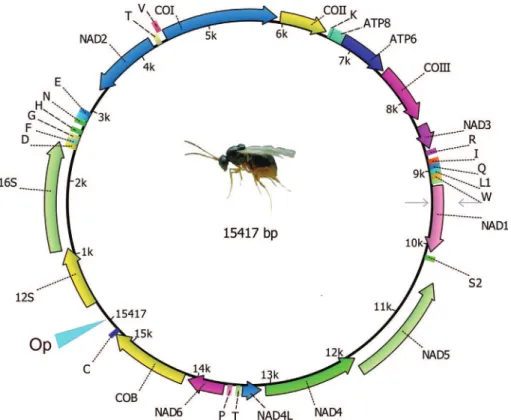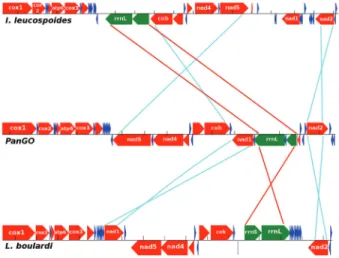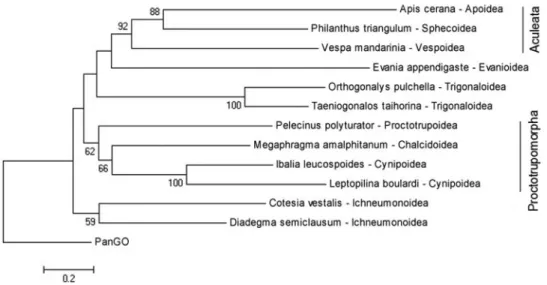The rearranged mitochondrial genome of
Leptopilina boulardi
(Hymenoptera:
Figitidae), a parasitoid wasp of
Drosophila
Daniel S. Oliveira
1, Tiago M.F.F. Gomes
1and Elgion L.S. Loreto
21
Curso Ciências Biológicas, Universidade Federal de Santa Maria (UFSM), Santa Maria, RS, Brazil.
2
Departamento de Bioquímica e Biologia Molecular (CCNE), Universidade Federal de Santa Maria
(UFSM), Santa Maria, RS, Brazil.
Abstract
The partial mitochondrial genome sequence ofLeptopilina boulardi (Hymenoptera: Figitidae) was characterized. Illumina sequencing was used yielding 35,999,679 reads, from which 102,482 were utilized in the assembly. The length of the sequenced region of this partial mitochondrial genome is 15,417 bp, consisting of 13 protein-coding, two rRNA, and 21tRNA genes (the trnaM failed to be sequenced) and a partial A+T-rich region. All protein-coding genes start with ATN codons. Eleven protein-coding genes presented TAA stop codons, whereas ND6 and COII that pre-sented TA, and T nucleotides, respectively. The gene pattern revealed extensive rearrangements compared to the typical pattern generally observed in insects. These rearrangements involve two protein-coding and two ribosomal genes, along with the 16 tRNA genes. This gene order is different from the pattern described forIbalia leucospoides (Ibaliidae, Cynipoidea), suggesting that this particular gene order can be variable among Cynipoidea superfamily members. A maximum likelihood phylogenetic analysis of the main groups of Apocrita was performed using amino acid sequence of 13 protein-coding genes, showing monophyly for the Cynipoidea superfamily within the Hymenoptera phylogeny.
Keywords: Mitogenome,Cynipoidea,Leptopilina,parasitic wasp. Received: March 12, 2016; Accepted: August 02, 2016
Leptopilina boulardi is a larval parasitoid of
Drosophilidae, mainly of the Drosophila species.
Ori-ginally from Africa, today it is almost cosmopolitan, hav-ing been found in the Mediterranean area, tropical Africa and the Americas (Allemandet al., 2002).Drosophila
spe-cies, primarilyD. melanogaster,are centenary model
or-ganisms andL. boulardiis an idealDrosophilapartner for
studying the relationship between insect-parasitoids in-volving ecology, evolutionary, physiology, immunology, and parasitoid viruses (Carton and Nappi, 1997; Varaldiet al., 2006; Dubuffetet al., 2007; Prévost, 2009).
Further-more, Guimarãeset al.(2003) put forth that this parasitoid
wasp has the potential to be used in strategies of integrated pest management (IPM) of frugivorous Diptera, mostly Drosophilidae pests likeDrosophila suzukiiandZaprionus indianus. L. boulardi belongs to the Cynipoidea
super-family, formed by five families of extant species and three other families that are extinct (Ronquist, 1999; Liuet al.,
2007; Sharkeyet al., 2012). Figitidae is the family which
has the largest number of described species within
Cynipoidea, with a global diversity estimate of 24,000 spe-cies, all being chiefly parasitoids of flies (Buffingtonet al.,
2007).
Complete mitochondrial genomes are useful models for molecular evolution and powerful tools for phylogen-etic and population studies. Most animal mitogenomes are about 16 kb in size and contain 37 genes: 13 protein-coding genes, 22 transfer RNA genes (tRNA), and two ribosomal RNA genes (rRNA) (Boore, 1999). Mitochondrial phylo-genomics has been used to study relationship among the more basal clades of living beings (Berntet al., 2013b), but it is also useful for analyses of more inclusive taxa (Ruiz-Trilloet al., 2008). For these studies, genomic sequences are used, as well as the mitochondrial gene order (GO). In insects, gene synteny is a well conserved character, and the arrangement more widely distributed is referred to as “Pancrustacea ancestral Gene Order” (PanGo). However, certain insects, such as Hymenoptera, Psocoptera, Phthiraptera, and others exhibit rearrangements in their GO, and this characteristic can be very informative for phylogenetic analysis (Weiet al., 2010; Babbucciet al., 2014).
So far, in the Cynipoidea superfamily, only Ibalia leucospoides, from the Ibaliidae family, has had its
mito-genome described (Maoet al., 2015). In the present study,
DOI: http://dx.doi.org/10.1590/1678-4685-GMB-2016-0062
Send correspondence to Elgion L. S. Loreto, Dept of Biochemistry and Molecular Biology, CCNE, Federal University of Santa Maria, Av. Roraima 1000, Camobi, 97105-900, Santa Maria, RS, Brazil. E-mail: elgion@base.ufsm.br
the nearly complete mitogenome ofL. boulardi(Figitidae)
is described. The main objective was to use this mitoge-nome to test the monophyly of the Cynipoidea superfamily and compare the synteny with I. leucospoides to verify
whether the GO is a conserved character in Cynipoidea.
Specimens of L. boulardi were collected in Santa
Maria, Brazil (latitude 34.95303 and longitude -120.43572). To collect the wasps, ripe bananas were placed in field sites for 4 days to allow oviposition. The fruits were then maintained in the laboratory until emer-gence of the flies and their parasitoid wasps (Ortizet al.,
2015). Genomic DNA was isolated from a pool of 20 indi-viduals using the NucleoSpin Tissue XS kit (Macherey-Nagel). The sample was sequenced using a Illumina HiSeq 2000 Next Generation Sequencing (NGS) device through the Fasteris DNA Sequencing Service (Plan-les-Ouates, Switzerland). A single-end approach with a read size of ~100 bp was employed. The reads were filtered by quality to eliminate low quality reads. The FASTX-Toolkit (http://hannonlab.cshl.edu/fastx_toolkit/) was imple-mented within the Galaxy webserver (Giardineet al., 2005;
Blankenberget al., 2010; Goeckset al., 2010) using a
qual-ity cut-off value of 20 and a percent of bases that should possess a quality value equal to or higher than the cut-off value of 90 (Ortizet al., 2015). A total of 35,999,679 reads
were selected as of high quality.
The mitogenome was assembled using the MITObim software package (Hahnet al., 2013), with 102,482 reads
being used in the assembly, this corresponding to 0.28% of total reads. The COI gene from Lepitopila victoriae
(AB583620.1) was used as the seed for the assembly. MITObim uses anin silicobaiting approach, which was
im-plemented in the MIRAbait module of the MIRA assembler (v3.4.1.1) (Chevreuxet al., 1999). TheL. boulardimtDNA
showed a coverage of 655.24 x (on average), and the test for circularity using the software mitoMaker showed it is not circularized. The sequence was deposited in GenBank un-der the accession number KU665622.
The characterization and annotation of the assembled
L. boulardi mitogenome was performed on the MITOS
Web Server (Berntet al., 2013a), using default parameters
and UGENE software (Okonechnikovet al., 2012),
respec-tively.
The sequenced length of the genome was 15,417 bp, containing 13 protein-coding, two rRNA, and 21 tRNA genes, as well as an A+T-rich region having 316 bp and 84.2% of A+T content (Figure 1). We believe that a small portion of the genome failed to assemble because it was not possible to identify the trnM sequence. The mtDNA ofL. boulardiis AT rich, totaling 80.3% A+T content. This high
A+T composition is typical of other hymenopterans, with values ranging from 82.4% to 87.2% (Weiet al., 2010). In
the Hymenoptera species here studied, these values range
from 77.7 to 87.4% (Supplementary Table S1). The plus strand comprised nine protein coding and two RNA genes, whereas the minus strand encompassed four protein coding genes and no RNA genes. All protein-coding genes initi-ated with an ATN codon, except for COI that started with the tetranucleotide, TTAG. Furthermore, among the pro-tein-coding genes 11 had typical stop codons, TAA and TAG, while the ND6 and COII genes showed an incom-plete stop codon T.
The synteny observed in theL. boulardimitogenome
differs from that found in PanGo (Figure 2). Two rear-rangements involved protein-coding genes, Nad1 is here positioned between Nad3 and Nad5, Nad2 suffered an in-version, changing from the plus strand to the minus strand, and the rRNA genes rrnL and rrnS also underwent an inver-sion. An extensive change of positions was involved in the tRNAs genes. A total of 16 tRNA genes changed their posi-tions compared with PanGo (trnL2, trnD, trnG, trnA, trnS1, trnN, trnE, trnF, trnH, trnS2, trnL1,trnV, trnI, trnQ, trnW, trnC) (Figure S1). Other five tRNA genes maintained synteny with respect to PanGo (trnK, trnR, trnT, trnP, trnY). As coverage is almost constant throughout the as-sembled genome, this indicates that the gene order is real. Looking at the full set of mitochondrial genes, an ample ar-ray of rearrangement was observed inL. boulardi when
compared with the PanGo pattern, that is considered the an-cestral gene order for insects.
Figure 2 also shows a synteny comparison of the
Ibalia leucospoides mitochondrial genome with PanGo.
TheIbalia leucospoidesmitogenome showed extensive
re-arrangements involving 15 tRNA genes, as well as seven protein-coding genes compared to ancestral PanGo.
Fur-thermore, it contains two extra trnM genes (Mao et al.,
2015).I. leucospoidesandL. boulardibelong to the same
superfamily, Cynipoidea, but are within different specific families. The first species is included in the Ibaliidae family and the second is a member of the Figitidae family. As can be observed in Figure 2, the rearrangements present in both genomes diverge significantly, suggesting that gene order is not conserved within the Cynipoidea and, thus, can be an important molecular marker for phylogenetic studies of this group, similar to other hymenopteran taxa (Oliveiraet al.,
2008; Weiet al., 2010; Maoet al., 2015).
To address the question of the phylogenetic position of L. boulardi, eleven available complete mitogenomes
were chosen as representatives of the main groups of Apocrita, as indicated by Sharkey (2007), Weiet al.(2010)
and Sharkeyet al.(2012). The species were:Apis cerana
-Apoidea (NC_014295);Cotesia vestalis- Ichneumonoidea
(NC_014272); Diadegma semiclausum -Ichneumonoidea
(NC_012708); Evania appendigaster - Evanioidea
(NC_013238); Vespa mandarinia - Vespoidea
(NC_027172); Megaphragma amalphitanum
-Chalcidoidea (NC_028196); Orthogonalys pulchella
-Trigonaloidea (NC_025289); Pelecinus polyturator
-Proctotrupoidea (NC_026865); Philanthus triangulum
-Sphecoidea (NC_017007); andTaeniogonalos taihorina
-Trigonaloidea (NC_027830); Ibalia
leucospoides-Ibaliidae (NC_026832). The PanGO sequence, represented by Drosophila incompta (KM275233) was used as
outgroup. These genomes were downloaded in January, 2016. The amino acid sequences of 13 coding genes of the mitogenomes were aligned separately using MUSCLE (Ed-gar, 2004) implemented in MEGA 5.0 (Tamura et al.,
2011), using default parameters. Subsequently the align-ments were concatenated and trees were constructed using the maximum likelihood method, also in MEGA 5.0. The final alignment had a length of 3715 amino acid without gaps and 3875 with gaps. The evolutionary model em-ployed was the aa-model mtRev (+F) and gamma distribu-tion with invariant sites (G+I). Gap-missing data were treated as complete deletions. The support for each clade was measured with bootstrap values determined through the analysis of 500 pseudoreplicates.
The phylogenomic analysis positionedL. boulardias
the sister species ofI. leucospoides(Figure 3). These
spe-cies belong to the same superfamily, Cynipoidea, but belong to different families (Figitidae and Ibalidae respec-tively), and thus formed a monophyletic clade within the Apocrita phylogeny. The branches observed in the obtained tree are, in general, in accordance with the study of the evo-lutionary relationship among the Hymenoptera groups con-ducted by Sharkey et al. (2012). The major difference
observed in the phylogenetic tree obtained here and that described by those authors is related to the group, Proctotrupomorpha, here represented by Cynipoidea, Proc-totrupoidea, and Chalcidoidea. In the data of Sharkeyet al.
Figure 2- Rearrangements observed in the available mitogenomes of
Cynipoidea compared to the Pancrustacea ancestral Gene Order (PanGo). InIbalia leucospoides,the mitogenome has three large rearrangements, with a repositioning of seven protein-coding and two rRNA genes. Minor rearrangements also occcurred within the 15 tRNA genes (Maoet al., 2015). InL. boulardi, there we found the presence of three large
(2012), Cynipoidea clustered with Proctotrupoidea, and this being the sister group to Chalcidoidea. In the results obtained here, Cynipoidea clustered with Chalcidoidea, and this grouping with Proctotrupoidea. The other cluster retrieved in the phylogeny consists of Aculeata (Apoidea, Sphecoidea and Vespoidea), having as sister group the Evanioidea. This clade clustered with Trigonaloidea. The relationship seen for this clade is, thus, similar to that re-ported by Sharkeyet al.(2012). Possible reasons for the
differences observed between our results and those ob-tained by Sharkeyet al.(2012) may be related to
differ-ences in the characters used for phylogenetic analysis. Sharkeyet al.(2012) used 392 morphological characters
and sequence data for four loci (18S, 28S, COI and EF-1a), while we used 13 mitochondrial genes.
In summary, we consider three main contributions of this study: i) the phylogenomic analyses showed thatL. boulardiandI. leucospoidesform a clade representative of
the Cynipoidea superfamily within the Hymenoptera phy-logeny, strengthening, as observed in other studies, the monophyly of the Cynipoidea superfamily; ii) the diver-gent gene order observed inL. boulardiandI. leucospoides
suggests that this character is not conserved in Cynipoidea; and iii) the description of theL. boulardipartial
mitochon-drial genome should be relevant for future phylogenomics studies in Hymenoptera, as well being useful to future pop-ulation genetics studies on this species.
Acknowledgments
The authors would like to thank Gabriel Wallau, Francine De Ré, and Mauro F. Ortiz for their assistance with bioinformatics. The study was supported by research grants and fellowships from Conselho Nacional de
Desen-volvimento Científico e Tecnológico (CNPq), PRONEX-FAPERGS (10/0028-7) and PROBIC/PRONEX-FAPERGS.
References
Allemand R, Lemaître C, Frey F, Boulétreau M, Vavre F, Nord-lander G, van Alphen J and Carton Y (2002) Phylogeny of six AfricanLeptopilinaspecies (Hymenoptera: Cynipoidea, Figitidae), parasitoids of Drosophila, with description of three new species. Ann Soc Entomol France 38:319-332. Babbucci M, Basso A, Scupola A, Patarnello T and Negrisolo E
(2014) Is it an ant or a butterfly? Convergent evolution in the mitochondrial gene order of Hymenoptera and Lepidoptera. Genome Biol Evol 6:3326-3343.
Bernt A, Donath F, Jühling F, Externbrink C, Florentz C, Fritsch G, Pütz J, Middendorf M and Stadler PF (2013a). MITOS: Improvedde novometazoan mitochondrial genome annota-tion. Mol Phylogenet Evol 69:313-319.
Bernt M, Bleidorn C, Braband A, Dambach J, Donath A, Fritzsch G, Golombek A, Hadrys H, Jühling F, Meusemann K,et al. (2013b) A comprehensive analysis of bilaterian mitochon-drial genomes and phylogeny. Mol Phylogenet Evol 69:352-364.
Blankenberg D, Von Kuster G, Coraor N, Ananda G, Lazarus R, Mangan R, Nekurtenko A and Taylor J (2010) Galaxy: A web-based genome analysis tool for experimentalists. Curr Protoc Mol Biol Chapter 19:Unit 19.10.1-21.
Boore JL (1999) Animal mitochondrial genomes. Nucleic Acids Res 27:1767-1780.
Buffington MI, Nylander JAA and Heraty JM, (2007) The phy-logeny and evolution of Figitidae (Hymenoptera: Cynipoidea). Cladistics 23:403-431.
Carton Y and Nappi AJ (1997).Drosophilacellular immunity against parasitoids. Parasitol Today 13:218-227.
Chevreux B, Wetter T and Suhai S (1999) Genome sequence as-sembly using trace signals and additional sequence informa-tion. Proccedings of the German Conference on Bioinfor-matics 99:45-56.
Figure 3- Maximum likelihood phylogenetic tree based on the amino acid sequences of 13 mitochondrial protein-coding genes for some representatives
Dubuffet A, Dupas S, Frey F, Drezen J-M, Poirie M and Carton Y (2007) Genetic interactions between the parasitoid wasp Leptopilina boulardi and its Drosophila hosts. Heredity 98:21-27.
Edgar RC (2004) MUSCLE: Multiple sequence alignment with high accuracy and high throughput. Nucleic Acids Research 32:1792-1797.
Giardine B, Riemer C, Hardison RC, Burhans R, Elnitski L, Shah P, Zhang Y, Blankenberg D, Albert I, Taylor J,et al.(2005) Galaxy: A platform for interactive large scale genome anal-ysis. Genome Res 15:1451-1455.
Goecks J, Nekrutenko A, Taylor J and The Galaxy Team (2010) Galaxy: A comprehensive approach for supporting accessi-ble, reproduciaccessi-ble, and transparent computational research in the life sciences. Genome Biol 11:R86.
Guimarães JA, Gallardo FE, Diaz NB and Zucchi RA (2003) Eucoilinae species (Hymenoptera: Cynipoidea: Figitidae) parasitoids of fruit-infesting dipterous larvae in Brazil: Iden-tity, geographical distribution and host associations. Zoo-taxa 278:1-23.
Hahn C, Bachmann L and Chevreux B (2013) Reconstructing mi-tochondrial genomes directly from genomic next-generation sequencing reads - A baiting and iterative mapping ap-proach. Nucleic Acids Res 41:E129.
Liu Z, Engel MS and Grimaldi M (2007) Phylogeny and geologi-cal history of the Cynipoid wasps (Hymenoptera: Cynipoidea). Am Mus Nat Hist Novitates 3583:1-48. Mao M, Gibson T and Dowton M (2015) Higher-level phylogeny
of the Hymenoptera inferred from mitochondrial genomes. Mol Phylogenet Evol 84:34-43.
Okonechnikov K, Olga G and Mikhail F (2012) Unipro UGENE: A unified bioinformatics toolkit. Bioinformatics 28:1166-1167.
Oliveira DCSG, Raychoudhury R, Lavrov DV and Werren JH (2008) Rapidly evolving mitochondrial genome and direc-tional selection in mitochondrial genes in the parasitic wasp Nasonia (Hymenoptera: Pteromalidae). Mol Biol Evol 25:2167-2180.
Ortiz MF, Wallau GL, Graichen DÂ and Loreto EL (2015) An evaluation of the ecological relationship between Drosophilaspecies and their parasitoid wasps as an
opportu-nity for horizontal transposon transfer. Mol Genet Genomics 290:67-78.
Prévost G (2009) Parasitoids ofDrosophila.Preface. Adv Para-sitol 70:xv.
Ronquist F (1999) Phylogeny, classification and evolution of the Cynipoidea. Zool Scripta 28:139-164.
Ruiz-Trillo I, Roger AJ, Burger G, Gray MW and Lang BF (2008) A phylogenomic investigation into the origin of Metazoa. Mol Biol Evol 25:664-672.
Sharkey MJ (2007) Phylogeny and classification of Hymenoptera. Zootaxa 1668:521-548.
Sharkey MJ, Carpenter JM, Vilhelmsen L, Heraty J, Liljeblad J, Dowling APG, Schulmeister S, Murray D, Deans AR, Ron-quist F, et al. (2012) Phylogenetic relationships among superfamilies of Hymenoptera. Cladistics 28:80-112. Tamura K, Peterson D, Peterson N, Stecher G, Nei M and Kumar
S (2011) MEGA5: Molecular evolutionary genetics analysis using maximum likelihood, evolutionary distance, and max-imum parsimony methods. Mol Biol Evol 28:2731-2739. Varaldi J, Petit S, Boulétreau M and Fleury F (2006) The virus
in-fecting the parasitoidLeptopilina boulardiexerts a specific action on superparasitism behaviour. Parasitology 132:747-756.
Wei S-J, Shi M, Sharkey MJ, van Achterberg C and Chen X-X (2010) Comparative mitogenomics of Braconidae (Insecta: Hymenoptera) and the phylogenetic utility of mitochondrial genomes with special reference to Holometabolous insects BMC Genomics 11:e371.
Supplementary Material
The following online material is available for this article: Figure S1 - Rearrangements of tRNA genes between
Leptopilina boulardiand PanGO.
Table S1 - Species used in this study, their superfamilies and families, accession numbers, data about the A+T re-gion and total A+T content.
Associate Editor: Ana Tereza R. Vasconcelos


